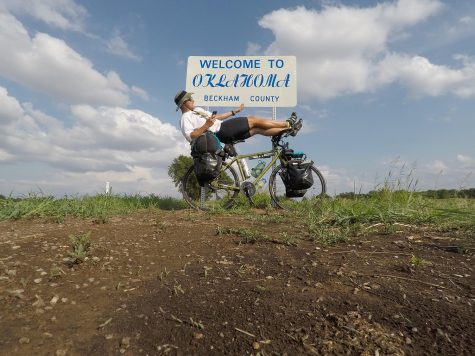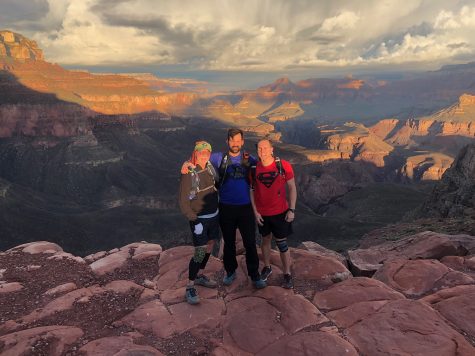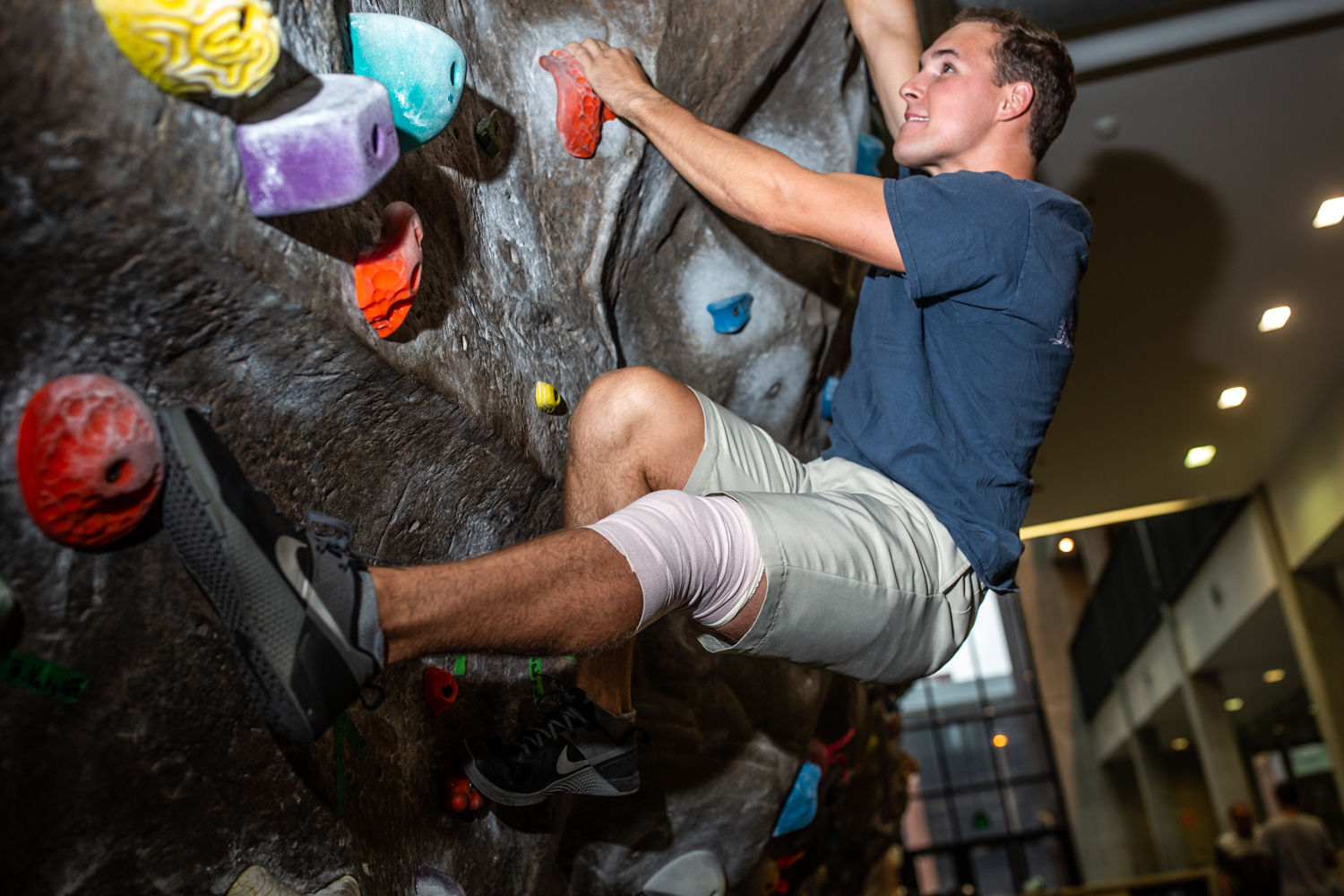Less than 2 years after a nearly fatal car accident, UI student runs 24 miles through Grand Canyon
Chase Thurman’s recovery from a nearly fatal car accident two years ago can’t keep him from achieving his goals. On Oct. 4, he ran a 24-mile race through the Grand Canyon, despite 11 pieces of metal in his body holding him together.
October 15, 2018
There is a certain chaos at the University of Iowa Campus Recreation & Wellness Center climbing wall on Monday nights. Ropes hang down like vines and climbers ascend, fall, and ascend again while belayers — those who hold the ropes at the bottom and let out slack for the climbers — chatter below. In the middle of this cluster of activity, UI student Chase Thurman is focused on certifying two top-rope climbers.
Friends call out to Chase and he greets them by name before quickly returning to the two climbers. He goes over knots, belaying form, and other tips with friendly expertise. At one point, a siren goes off somewhere in the Rec. While most heads swivel to look for the source, Chase does not flinch.
It’s clear the wall is a special place for the 22-year-old. Surrounded by friends and rock climbing, Chase looks happy and healthy here. One wouldn’t even realize he has 11 pieces of metal in his body holding him together.
• • •
The two climbers Chase is certifying belay for each other, and Chase takes a small break. He shakes out and massages his knee. It feels wobbly, he tells me that Monday. He asks if I want to feel it. I decline.
I ask what his plan is if his knee doesn’t feel better by tomorrow, when he gets on a plane to run the Rim2Rim on Oct. 4.
Let’s hope it’s better by then, he jokes.
That’s the last thing I can remember, is hearing the distinct ‘click’ of the seat belt. And then I woke up three days later in the hospital.
— Chase Thurman, UI student
The Rim2Rim is a 24-mile run through the Grand Canyon. Chase is running the route, climbing a total of 7,260 feet, with his doctor and another runner with a knee injury.
Fellow climbers wish Chase luck as they pass by, and one teases him that it might be too dangerous. Chase laughs and says he wouldn’t do it if it wasn’t dangerous.
Chase does have limits. He rubs his leg and thinks about what it would take for him not to run the Rim2Rim.
“If I can’t move my knee the morning of the run, then I won’t do it,” he says. “But there’s not a lot that would keep me from running it.”
That Thursday, despite a wobbly knee, Chase completed the Rim2Rim in 10 hours, beating the support vehicle. He posted on his Instagram a simple piece of advice:
“Get out. Get lost. And be found.”
• • •
“Click.”
“That’s the last thing I can remember, is hearing the distinct “click” of the seat belt. And then I woke up three days later in the hospital.”
On Jan. 13, 2017, Chase was driving from his paternal grandparents’ house to his maternal grandparents’ house in Macomb, Illinois. He needed to return his grandma’s car before heading back to the UI.
His paternal grandma leaned her head out the door and told the then-20-year-old to be safe and buckle up. “Click.”
Chase remembers nothing of the following events, but he has pieced together recollections from first responders, doctors, and loved ones. He was driving along the familiar roads of his hometown when, while crossing an intersection, a gray SUV T-boned his grandma’s yellow Volkswagen Beetle at 90 mph.
Upon impact, Chase broke a rib, a foot, and a hand. More seriously, he punctured both lungs, suffered a traumatic brain injury, and a compound fracture of his femur. He also had contusions on his heart and spleen.

Chase Thurman described his grandma’s car as a “metal coffin” after his accident.
His injuries were so severe, a helicopter had to fly him to the nearest hospital. Chase’s grandpa was at the scene of the crash after getting a phone call about a crushed bug that Chase later described as a “metal coffin.” The grandparents called Chase’s mom, Meg Thurman, and said he probably wouldn’t make it.
After being rushed to Blessing Hospital in Quincy, Illinois, doctors gave Chase a 35 percent chance of survival and told the Thurmans if their son did live, he would probably lose his leg.
Several operations later, Chase not only lived, but he kept his left leg despite the severity of the compound fracture on his femur.
“The impact alone would have killed an average person,” said Emily McVeer, administrative coordinator of orthopedics at Blessings Hospital.
But Chase is a clear exception.
Over the past year and a half, Chase has undergone eight surgeries and several smaller operations. He spent 22 days in the hospital and eight months moving from wheelchair to crutches to a cane.
The recovery process was more frustrating to Chase than it might be for most because he had been active all his life. He cycled, ran triathlons and marathons, wrestled, and was involved in ROTC.
He told me a story of when he was 16 years old and went scuba diving in the Cayman Islands with his mom. They were only allowed to dive down to 60 feet. Immediately, he went to 112 feet.
“The instructor was pissed,” he said and laughed.
That was the kind of life Chase lived.
“We called him Chase the Lion,” Meg said. “Whatever he put his mind to growing up, he was going to make it happen.”
Despite a rapid physical recovery, Chase was frustrated with what he considered to be slow progress. To go from such an active lifestyle to nothing was jarring, he said.
“His recovery didn’t allow for the physical life he was used to,” said UI student Josie Thomas, Chase’s best friend. “It was tough for him to not live the life he knew.”
The lowest point came 10 weeks after the crash, when Chase tried to walk his dog a little farther than usual. He grew tired and had to sit down on the side of the street, where he broke down, wondering if this was going to be his life.
“He had to have a tipping point where he needed to decide, am I going to let this take over? Or am I going to take tragedy and turn it into a triumph?” Meg said.
The physical recovery clearly came more naturally to Chase than it does others. Soon after he could walk unassisted, Chase began rebuilding himself, training on his stationary bike. McVeer said Chase was unusually motivated.
“When most people are recovering from the same [injuries] that he did, we need to ask them to push more. With Chase, it was the opposite,” McVeer said. “We had to tell him to slow down.”
Only five months after the crash, Chase completed a sprint triathlon. His foot was still broken. Doctors said he shouldn’t have been able to walk.
Chase’s father, Dr. Lance Thurman, said Chase often fights through pain. In high school, Chase broke his leg while wrestling. Chase knew he was hurt but not knowing about the break, he tried to run sprints with his team. Only then did he begin to suspect the extent of his injury.
“It’s a lot of grit and determination,” the elder Thurman said.
• • •
The Englert is packed on Sept. 20, a Thursday night, for the SALT Company’s weekly worship service. Even though he has only been to SALT twice this semester, Chase interacts with almost every person he sees. Thomas says this is typical behavior.
I went through a lot of rough patches where I asked, ‘If there is a God, why would He do this to me?
— Chase Thurman
Before his accident, Chase viewed church and SALT as part of his routine, a way to stay connected with his values and religious upbringing. His faith was put to the ultimate test after his accident. Faced with the possibility of never living the same active lifestyle as before, Chase struggled with doubt.
“I went through a lot of rough patches where I asked, ‘If there is a God, why would He do this to me?’ ” Chase wrote down on the back of a pamphlet for my reference. “But after coming to terms with how impossible it was that I was still alive, my doubt turned into resolve.”
Thurman said the accident ended up being the proof Chase was looking for.
The SALT worship band begins, but after pointing out the people he knows in the band to me, Chase is distracted by an ROTC miscommunication in a group chat and spends much of the sermon writing down his personal thoughts about religion.
“I’ve questioned a lot of teachings in church in a way that makes people who go [to SALT] feel weird,” Chase wrote. “Through my questioning, I’ve learned a lot that confuses me, but more that affirms that I believe the Bible to be true.”
• • •
Chase can’t stand small talk anymore. He used to tolerate it but now he wonders why waste the time? Why not have real conversations?
While we get coffee, Chase asks for the barista’s name and how he likes the job. Chase’s All-American look of flannel, jeans, and a baseball cap doesn’t exactly mesh with the barista’s earrings and tattoos, but they kill two or three minutes talking.
People have always been a source of energy for Chase. He’s constantly interacting with people; if he’s going somewhere for lunch, he’ll grab a friend first. He’ll skip a run if someone asks him to climb instead. Almost everywhere he goes, he knows someone.
RELATED: UI legend reflects on 50 years of fighting for gender equality in intercollegiate athletics
While recovering, Chase discovered just how important people are in his life. He said he could have never recovered without the support system of his loved ones. Not just friends and family, but former school administrators and ex-girlfriends alike rallied to support him. He said it was inspiring how people came together.
Chase said he is now much more intentional about his relationships with those around him. He wants to make connections that count.
“He was a nice guy,” Chase said about the barista and laughed. “Think I could pull off those tattoos?”
• • •
Chase has a theory: Every person inevitably thinks, “What if I ran a marathon?’ or ‘What if I traveled the world?’ ” Most people have this thought but think it would be crazy to actually do it.

Chase stopped at the Oklahoma border for a photo opportunity as he cycled from California to New York this summer.
After his accident, Chase thinks it would be crazy not to do it.
While in the hospital, someone brought Chase a cycling magazine. He read a story about people who rode their bikes across the entire country. He skipped the “what if” entirely, and even though he still couldn’t walk unassisted, he decided he was going to cycle coast to coast.
“It was six months after the accident,” Meg said and laughed. “He came home and said ‘Mom, I think I need to take some time off school to bike across America.’ Like … what?”
On June 3, 2018, Chase left from Santa Monica Pier. He rode his bike 3,453 miles, camping along the way. He ended in Grand Central Station in New York City 54 days later. Thurman called it a pilgrimage.
“It was happy and sad and wonderful,” Chase said. “I mean, I was by myself, I didn’t know anyone. I had a lot of time to think about what happened to me and all the people in my life.”
Chase smiles, remembering the strangers in Arizona who bought him lunch after hearing his story, his friend who unexpectedly met up with him in Washington, and his dad and dad’s friend cycling along with him when he hit Illinois.
“We laughed,” Thurman said. “We did a lot of laughing.”
• • •
A few weeks ago, Chase showed up at the wall with a leg brace that stretched from his mid thigh to mid calf. During his bike ride across the country, his knee had filled with fluid, and he had to get it drained, he told me.
Leg brace and all, Chase was as cheery as usual while belaying and calling instructions to a climber. He might have made a quick recovery, but his body still takes more wear and tear than it used to. Not used to being held back, Chase fights through the pain.
“When you live through something no one could have lived through, you can push through [pain],” Chase said. “You just have to keep going.”
While on his biking journey, the screw in his knee would sometimes dig too far and hit a nerve. He said it felt like a knife in his kneecap.
Despite the pain and long-term risks of such a high level of physical activity, he continues to push himself. His parents sometimes worry, but they said there’s no stopping him.
“It was unnerving for quite some time. But when you see your child succeeding and the joy in their voice and their face … all of that [worry] goes away,” Meg said. “… None of us are guaranteed a tomorrow.”
To Chase, he’d rather be in pain than stand still. When he was confined to bed rest, Chase was at the mercy of flashbacks, mood swings brought on by his head injury, and the maddening doubts that his life would ever return to normal. Chase said if he doesn’t keep setting these goals and achieving them, he’ll go crazy.
“I can prove to myself that I’m still one piece. That I’m still Chase.”

From left to right, Randy Moore, Jeremiah Moore, and Chase Thurman pose at the Grand Canyon after completing their 24-mile, 10-hour run.
